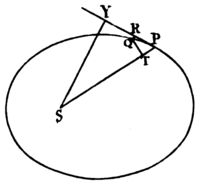ratio of the principal latera recta directly. Pl. 6. Fig; 2.

From the focus S, draw SY perpendicular to the tangent PR, and the velocity of the body P will be reciprocally in the ſubduplicate ratio of the quantity . For that velocity is as the infinitely ſmall arc PQ deſcribed in a given moment of time, that is. (by lem. 7.) as the tangent PR; that is, (becauſe of the proportionals PR to QT and SP to SY) as , or as SY reciprocally and directly; but SP x QT is as the area deſcribed in the given time, that is (by prop. 14.) in the ſubduplicate ratio of the latus rectum, Q. E. D.
Cor. 1. The princ[i]pal latera recta are in a ratio compounded of the duplicate ratio of the perpendiculars and the duplicate ratio of the velocities.
Cor. 2. The velocities of bodies, in their greateſt and leaſt diſtances from the common focus, are in the ratio compounded of the ratio of the diſtance inverſely, and the ſubduplicate ratio of the principal latera recta directly. For thoſe perpendiculars are now the diſtances.
Cor. 3. And therefore the velocity in a conic ſection, at its greateſt or leaſt diſtance from the focus. is to the velocity in a circle at the ſame diſtance from the centre, in the ſubduplicate ratio of the principal latus rectum to the double of that diſtance.
Cor. 4. The velocities of the bodies revolving in ellipſes, at their mean diſtances from the common focus, are the ſame as thoſe of bodies revolving in circles, at the ſame diſtances; that is (by cor. 6. prop, 4-) reciprocally in the ſubduplicate ratio of the diſtaces.



